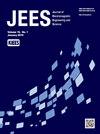GPR Image Recovery Effect on Faster R-CNN-Based Buried Target Detection
IF 1.7
3区 工程技术
Q3 ENGINEERING, ELECTRICAL & ELECTRONIC
Journal of electromagnetic engineering and science
Pub Date : 2022-09-30
DOI:10.26866/jees.2022.5.r.127
引用次数: 2
Abstract
Measurements acquired through ground-penetrating radar (GPR) may contain missing information that needs to be recovered before the implementation of any post-processing method, such as target detection, since buried target detection methods fail and cannot produce desired results if the input GPR image contains missing information. This study proves that the recovery of missing information in a GPR image has a direct influence on the performance of subsequent target detection methods. Thus, state-of-the-art matrix completion methods are applied to the GPR image with missing information in both pixel- and column-wise cases with different missing rates, such as 30% and 50%. After the GPR image is successfully recovered, the faster region-based convolutional neural network (Faster R-CNN) target detection method is applied. The performance correlation between matrix completion accuracy and the target detection method’s confidence score is analyzed using both quantitative and visual results. The obtained results demonstrate the importance of GPR image recovery prior to any post-processing implementation, such as target detection.GPR图像恢复对基于R-CNN-的地下目标快速检测的影响
通过探地雷达(GPR)获得的测量结果可能包含缺失信息,需要在实施任何后处理方法(如目标检测)之前进行恢复,因为如果输入的GPR图像包含缺失信息,埋地目标检测方法就会失败,无法产生期望的结果。本研究证明GPR图像中缺失信息的恢复直接影响到后续目标检测方法的性能。因此,将最先进的矩阵补全方法应用于具有不同缺失率(如30%和50%)的像素和列方向缺失信息的GPR图像。在GPR图像恢复成功后,采用更快的基于区域的卷积神经网络(faster R-CNN)目标检测方法。从定量和视觉两方面分析了矩阵补全精度与目标检测方法置信度评分之间的性能相关性。所得结果表明,GPR图像恢复在任何后处理实现(如目标检测)之前的重要性。
本文章由计算机程序翻译,如有差异,请以英文原文为准。
求助全文
约1分钟内获得全文
求助全文
来源期刊

Journal of electromagnetic engineering and science
ENGINEERING, ELECTRICAL & ELECTRONIC-
CiteScore
2.90
自引率
17.40%
发文量
82
审稿时长
10 weeks
期刊介绍:
The Journal of Electromagnetic Engineering and Science (JEES) is an official English-language journal of the Korean Institute of Electromagnetic and Science (KIEES). This journal was launched in 2001 and has been published quarterly since 2003. It is currently registered with the National Research Foundation of Korea and also indexed in Scopus, CrossRef and EBSCO, DOI/Crossref, Google Scholar and Web of Science Core Collection as Emerging Sources Citation Index(ESCI) Journal. The objective of JEES is to publish academic as well as industrial research results and discoveries in electromagnetic engineering and science. The particular scope of the journal includes electromagnetic field theory and its applications: High frequency components, circuits, and systems, Antennas, smart phones, and radars, Electromagnetic wave environments, Relevant industrial developments.
 求助内容:
求助内容: 应助结果提醒方式:
应助结果提醒方式:


